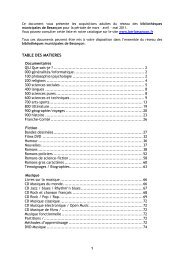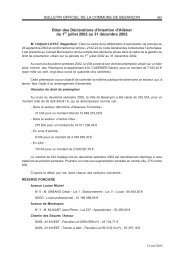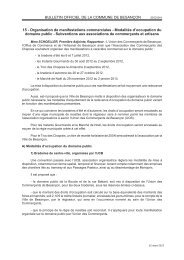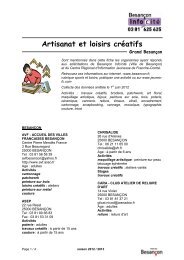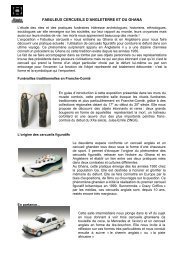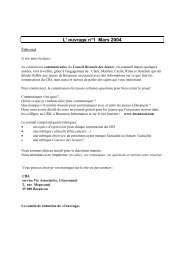An inventory of works within the city walls - Besançon
An inventory of works within the city walls - Besançon
An inventory of works within the city walls - Besançon
Create successful ePaper yourself
Turn your PDF publications into a flip-book with our unique Google optimized e-Paper software.
Vauban and <strong>Besançon</strong><br />
Vauban made best possible use <strong>of</strong><br />
<strong>the</strong> natural defences <strong>of</strong> <strong>the</strong> <strong>Besançon</strong><br />
site, with <strong>the</strong> citadel, <strong>the</strong> masterpiece<br />
among all <strong>the</strong> defence <strong>works</strong> at <strong>the</strong><br />
narrowest and highest point,<br />
<strong>the</strong> right-bank enclosure with Fort<br />
Griffon, bastions and demi-lunes<br />
(ravelins) and an innovative system<br />
on <strong>the</strong> left bank, taking into account<br />
<strong>the</strong> surrounding heights which,<br />
higher than <strong>the</strong> citadel, <strong>of</strong>fered<br />
strategic positions against any<br />
attacker. Adapting <strong>the</strong> <strong>works</strong> on<br />
<strong>the</strong> town site to marvellous effect,<br />
Vauban made <strong>Besançon</strong> into<br />
a defensive bastion against <strong>the</strong><br />
Germanic lands, a role reinforced<br />
fur<strong>the</strong>r in <strong>the</strong> eighteenth century.<br />
Vauban’s <strong>works</strong> at <strong>Besançon</strong> were<br />
completed in three stages:<br />
- between 1675 and 1683 <strong>the</strong> town<br />
was provided with a mighty citadel ;<br />
- between 1675 and 1695, <strong>the</strong><br />
fortifications <strong>of</strong> <strong>the</strong> loop wall and<br />
<strong>the</strong> Battant ring <strong>of</strong> defences<br />
were rebuilt ;<br />
- from 1680 (and into <strong>the</strong> nineteenth<br />
century), barracks were built on<br />
open spaces to <strong>the</strong> east <strong>of</strong> <strong>the</strong> <strong>city</strong>:<br />
<strong>the</strong> Saint-Paul and Saint-Pierre<br />
barracks, to accommodate 1,500<br />
to 2,000 garrisoned soldiers.<br />
After Vauban<br />
In <strong>the</strong> nineteenth century, constant<br />
progress in artillery technology,<br />
in particular in <strong>the</strong> use <strong>of</strong> canons with<br />
rifled barrels and shells, considerably<br />
increased <strong>the</strong> effectiveness <strong>of</strong> artillery<br />
and rendered Vauban’s defences<br />
obsolete. A new system <strong>of</strong> defences<br />
would be required to stand up to<br />
<strong>the</strong> increasingly powerful artillery.<br />
The ancient concept <strong>of</strong> siege<br />
warfare in which a town resisted<br />
attack using <strong>the</strong> protection <strong>of</strong> its <strong>walls</strong>,<br />
was succeeded by <strong>the</strong> idea <strong>of</strong> <strong>the</strong><br />
military camp protected by semi-buried<br />
fortifications built on surrounding<br />
high ground: detached forts.<br />
From 1945, <strong>the</strong> development <strong>of</strong><br />
defence policy and techniques having<br />
robbed <strong>the</strong> town <strong>of</strong> its role as<br />
a stronghold on <strong>the</strong> eastern front,<br />
<strong>the</strong> military authority abandoned most<br />
<strong>of</strong> <strong>the</strong> sites situated in <strong>the</strong> loop,<br />
as well as most <strong>of</strong> <strong>the</strong> <strong>works</strong> on <strong>the</strong> ring<br />
<strong>of</strong> defences and <strong>the</strong> barracks.<br />
In 1959, <strong>the</strong> town bought back <strong>the</strong><br />
citadel from <strong>the</strong> army which no<br />
longer had use for it. The military<br />
also transferred to it and to <strong>the</strong><br />
Département, <strong>the</strong> old <strong>city</strong> forts<br />
which <strong>the</strong>n became administrative<br />
or cultural heritage buildings ; those<br />
belonging to <strong>the</strong> <strong>Besançon</strong>'s ring<br />
<strong>of</strong> defences were transferred to <strong>the</strong><br />
neighbouring communities from 1962.<br />
The army now only owns two forts,<br />
at Montfaucon and Montboucons.<br />
Modifications to <strong>the</strong> defence system <strong>of</strong><br />
<strong>the</strong> site in <strong>the</strong> nineteenth and twentieth<br />
centuries have however allowed several<br />
features to survive which bear witness<br />
to <strong>the</strong> grand scale <strong>of</strong> <strong>the</strong> old military<br />
base, due to <strong>the</strong> <strong>works</strong> <strong>of</strong> Vauban.



